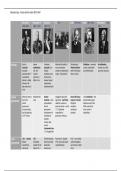Berenice Ings – Russia and its rulers 1855-1964
Alexander II Alexander III Nicholas II PG 1917 Lenin 1917-1924 Stalin 1924- 1952 Khrushchev – 1952-
1855-1881 1881 – 1894 1894-1917 1964
Ideology Stuck to Intense Continued Reflected the beliefs of Dictatorship of Totalitarian – command De-stalinisation,
autocratic authoritarian autocratic rule – more conservative Marxist-Leninism, society, centralisation however not a shift
principles – rule, ‘the October members of professional belief in the labour and collectivisation away from autocracy
especially after 1st reaction’, manifesto, move classes – liberal period theory of value
assassination response to to democracy
attempt – willing father’s rule however impact
reformer, still cushioned by
kept autocracy in fundamental laws
mind
Central When AII came to Remained the October Struggled to deal with Second all Russian 1936 constitution – new
government the throne – same manifesto – more opponents – April thesis congress of soviets, representative organs:
central representative called for a seizure of Petrograd Supreme soviet of the
government form of power by Soviets – end of revolution, USSR, soviet of the
structure dating government – 1917, Bolsheviks constituent union, soviet of
back to beginning abandonment of responsible for assembly nationalities,
of 19th century committee of governance of Russia –
ministers
-Dumas, state
council,
Fundamental laws
1906 changed this
Local 1864. – zemstva 1881 – The third element From march – October 1921 – new criminal
government Elected centralised, Liberal voice that 1917, some claim soviet code that legalised
membership, minister for the dominated controlled Russia use of terror to deter
selected by interior, JPs -> zemstva and crime
,Berenice Ings – Russia and its rulers 1855-1964
property land captains Dumas that called
qualification for remodelling of
1870 – Dumas – central
entry government
qualification
harder than Workers councils –
zemstva Petrograd soviets
of worker’s
1864 – legal deputies –
reform, jury coordinate strikes
system- , + protect factory
hierarchy of workers
courts, better
pay, public
attendance
1877 – court for
political cases,
following
assassination
attempt – failed
Vera Zasulich
case
Reform Hoped by freeing Introduced duma Passed liberal reforms, Communists used
serfs – more to quieten those dismantled Okhrana– reforms to deal with
happier less likely who wanted hoped create stability opponents in a more
to riot constitutional direct fashion
reforms – all tsars
implements
policies to
appease
opposition
The secret Third section -> Feb 1917 –Okhrana Dec 1917 – Cheka 1934 – NKVD formed 1954 – reorganised
police Okhrana 1880 disbanded established 1943 – replaced by into 2 – refined
1922 – disbanded NKGB version of the MVD +
replaced by GPU 1946 – replaced by 2 KGB
1924 – expanded + bodies: MGB + MVD 1964 – all prior
, Berenice Ings – Russia and its rulers 1855-1964
named OGPU measures reduced
The army 1855 – army Russification – 1905-1917 – used Lenin encouraged soldiers Bolsheviks deployed Red army used for grain
numbered increased role in to dismantle to form MRC – vanguard military to requisitioning,
around 1,400,00 peace keeping strikes + protests, to revolution, seized consolidate power – administer purges and
– mainly force Feb 1917 – issue power from Kerensky flash strikes by civil the great terror –
peasants of deserting – servants and HOWEVER, internal
estimated 150,000 financial workers purging of leaders –
members of Red army – including marshal
Petrograd garrison instrumental to Tukhachevsky
supported winning civil war – 5 WWII – enormous
revolution million conscripts by military causalities,
the end. White army some desertion but
only had 500,000 – ordered to fight to the
also imposed war ‘last drop of blood’
communism After WWII – 1945-1953,
alongside cheka military leaders treated
Feb 1921 Kronstadt with suspicion despite
rebellion – desertion heroics in war
Censorship Glasnost 1881-91 – Reverted to WWI – russian people, After seizure of 1932 – all literary groups Censorship eased –
1865 – clampdown on glasnost – especially troops, subject power, abolished closed down, had to join late 50s, 65,000 books
censorship publications expansion of press to censorship – gained press freedom the union of soviet published a year and
replaced, 1894 – news from foreign 1921 – agitation and writers by 1959 – 135,000
increase in prepublication broadcasts propaganda 1934 – first congress of libraries containing
newspapers, censorship department the group announced 8000 million books
periodicals and disappeared founded, to promote material had to
books idealised picture of produced under
russian life ‘socialist realism’ – those
who rebelled, arrested,
exiled or executed
WWII – high degree of
censorship, radio
distorted, news
fictionalised and
restrictions placed on
the arts to prevent
bourgeois behaviour –
soviet man




